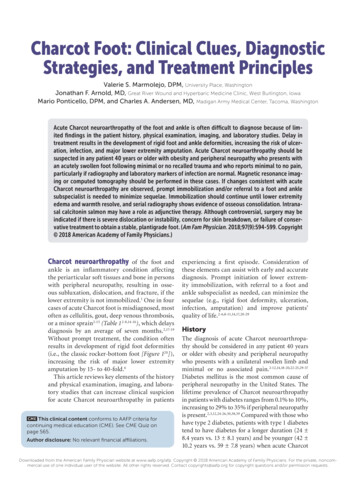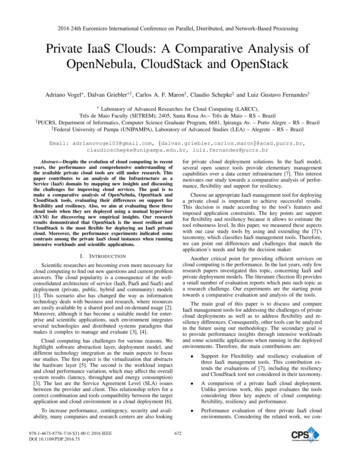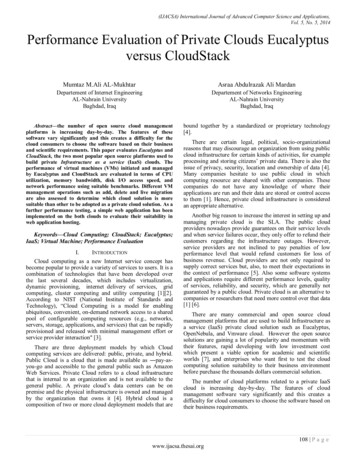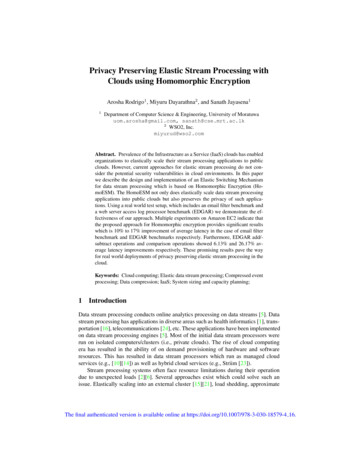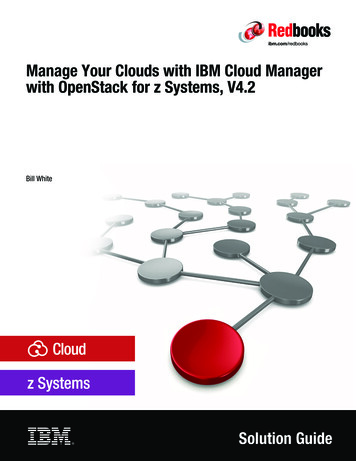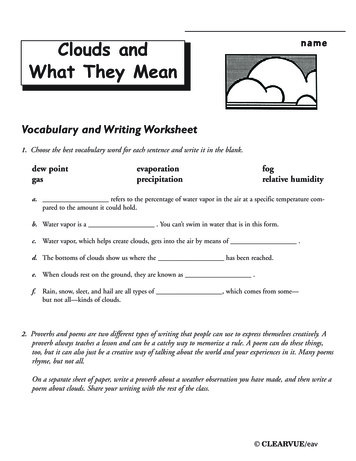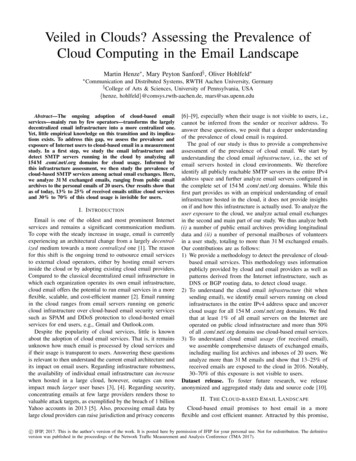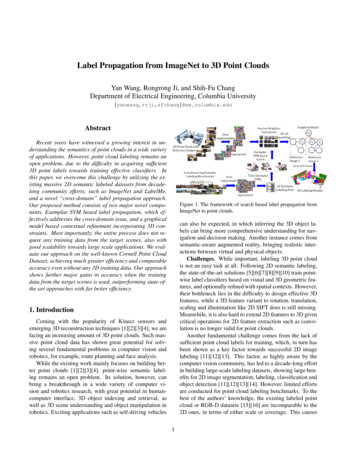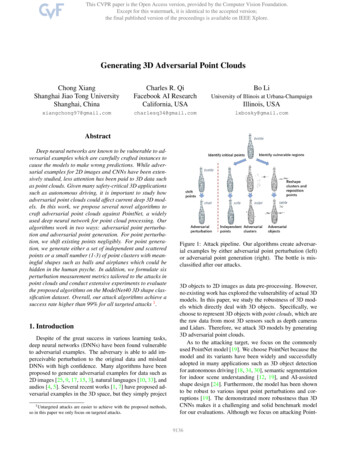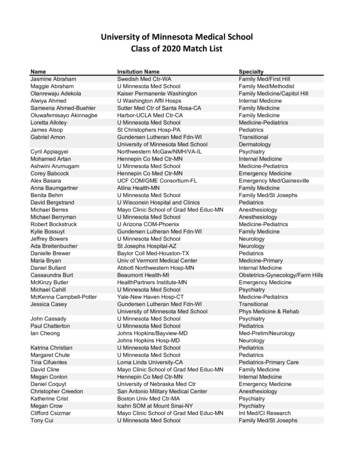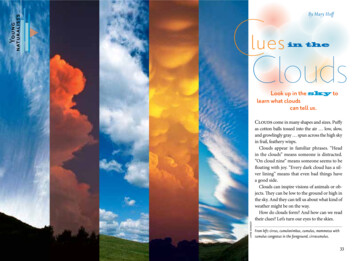
Transcription
Youngnat ural istsCCloudsBy Mary Hoffluesin theLook up in the sky tolearn what cloudscan tell us.LAYNE KENNEDYClouds come in many shapes and sizes. Puffy32Minnesota Conservation VolunteerJuly–August 2018as cotton balls tossed into the air low, slow,and growlingly gray spun across the high skyin frail, feathery wisps.Clouds appear in familiar phrases. “Headin the clouds” means someone is distracted.“On cloud nine” means someone seems to befloating with joy. “Every dark cloud has a silver lining” means that even bad things havea good side.Clouds can inspire visions of animals or objects. They can be low to the ground or high inthe sky. And they can tell us about what kind ofweather might be on the way.How do clouds form? And how can we readtheir clues? Let’s turn our eyes to the skies.From left: cirrus, cumulonimbus, cumulus, mammatus withcumulus congestus in the foreground, cirrocumulus.33
Water on WingsWhen you think of water, you probably think of a liquid. But water exists in other forms, too. When it getscold, it turns into a solid—ice. Andwhen it gets really warm, it turns intoa gas—water vapor. Invisible watermolecules are in the air all around us,in every breath we take.When those warm water moleculescool enough, they can change again.With the help of tiny bits of dust orother particles, they can condense, orturn back into liquid. Suspended in theair, the tiny drops (or, if it’s really cold,ice crystals) form floating objects weknow as clouds.What causes water molecules suspended in the air to cool down so theyFuncan condense into clouds? Earth’s atmosphere is made up of layers. Mostclouds are in the bottom layer. Theymove with the air masses that bringdifferent types of weather. Sometimesthey run into each other. When theydo, one slides up and over the otherone. The air mass closest to the groundis warm and moist. As the air rises itcools, and water vapor condenses andforms clouds that we can see.Sometimes the water droplets thatmake up clouds stay suspended inthe air. But when they get too crowded, or cool down enough, they canform larger clumps and fall to Earthin the form of rain, snow, or anotherform of precipitation.FactAt any time, clouds cover about three-quarters of Earth’s surface.Clouds can be big or small, thin orthick, high or low. Different clouds formunder different conditions, and thoseconditions affect what they look like.Puffy clouds form when the sunhits objects on the surface of the earth,heating them up. The heated air risesinto the sky until it gets to a zone cool34enough for droplets to form from themoisture it holds.Stringy clouds form when wind, rather than warmth, carries air skyward. Thedirection of the strands that make upthe cloud can tell us something aboutthe wind that was blowing when thecloud formed.Minnesota Conservation VolunteerTAINA LITWAKParade of CloudsJuly–August 201835
Weather Clue: Cumulus clouds generallysignal good weather—but beware if theyturn into cumulonimbus clouds!PETER BOULAY, DNRNimbostratus clouds cover the sky, block thesun, and create rain or snow. They are oftendark gray. Think “gloomy day,” and you areprobably picturing nimbostratus clouds.Weather Clue: If the air is filled with nimbostratus clouds, there’s a good chance it’s raining or snowing—or will be before too long.PETER BOULAY, DNRStratocumulus clouds form rounded sheetsand layers low in the sky. They are puffy ratherthan stringy and cover most or all of the sky.Weather Clue: Stratocumulus clouds tell usthat we may see rain soon, but the weatherwill quickly clear up.In a FogHave you ever wondered what it’s like inside acloud? If you’ve ever walked around in a fog,you already know! Fog is simply a cloud that isso low it actually touches the ground.Cumulonimbus clouds are thick,dense, and tall. They form whenwarm air near the ground is sweptupward and cools down. They areusually flat and spread out at the top.Weather Clue: Cumulonimbus cloudsoften bring thunderstorms, hail, andeven tornadoes.BILL MARCHELLow CloudsStratus clouds are low and gray and mayproduce rain or snow. When you say “cloudyday” you are probably talking about stratusclouds covering the sky.Weather Clue: Stratus clouds signal the potential for light snow or rain ahead, withpossible clearing overnight.PHOTOGRAPH BY RICHARD HAMILTON SMITH36Minnesota Conservation VolunteerPETER BOULAY, DNRScientists group clouds into 10 main categories. Which category a cloud is independs on how high in the sky it is, the shape it takes, and whether it producesrain, snow, or other precipitation. The types of clouds you see in the sky canprovide valuable clues about what kind of weather might be ahead.Cumulus clouds are the puffy, “cotton ball”clouds people like to imagine as puppies,faces, turtles, and other shapes. They aremade up of liquid water rather than ice. Cumulus clouds tend to be lighter-colored atthe top than at the bottom.July–August 2018PETER BOULAY, DNR10 Kinds of Clouds37
High CloudsPETER BOULAY, DNRAltostratus clouds cover the sky on a “grayday.” The sun may peek through, but itdoesn’t show a halo as it does for cirrostratus clouds (see page 40). Altostratus cloudsmay contain both ice and water droplets.FunWeather Clue: Altostratus clouds tell usthat rain or snow is likely on the way.FactIn summer, cumulus clouds are more common. In winter, stratusclouds are more common.PETER BOULAY, DNRAltocumulus clouds are the most commonmedium-height clouds. They contain waterrather than ice and are small and puffy—likepopcorn or cotton balls in the sky. If they arethick, they may look gray. Altocumulus cloudsare often found with other kinds of clouds.FunFunFactCities tend to have more clouds than rural areas.Cirrus clouds are thin and wispyand sometimes resemble feathers.High in the sky where temperatures are low, they usually are madeup of ice crystals rather than liquidwater. As light interacts with the icecrystals, you may see a “halo” effectaround the sun or moon.Weather Clue: Cirrus clouds tell usthat the weather is changing. Often,pleasant weather is ahead.LAYNE KENNEDYMedium-Height CloudsWeather Clue: Prepare for thunderstormslater in the day; after that, good weather ison its way.Mouth CloudsCan a person make a cloud? If you live in Minnesota, chances are you already have! When youtalk or breathe outdoors in cold weather, thewater vapor in the warm, moist air from insideyour body hits the cold, dry outdoor air andcondenses, forming miniature clouds in front ofyour eyes.FactIn winter, nighttime clouds help keep daytime warmth close toEarth. If there are no clouds, the warmth can escape skyward,resulting in cold, crisp nights.38PHOTOGRAPH BY LAYNE KENNEDYMinnesota Conservation VolunteerJuly–August 201839
Name These CloudsCirrostratus clouds are alsohigh in the sky. They tend tobe smoother and cover the skymore completely than cirrusclouds. They may create a haloeffect around the sun or moon.1.2.Weather Clue: Cirrocumulus clouds tellus the weather will likely be cold, but therewill be no snow anytime soon. nV3.4.BILL MARCHELPETER BOULAY, DNRCirrocumulus clouds are high cloudswith lumps or wrinkles. They are relativelyuncommon. Often they are cirrus or cirrostratus clouds grown old.WALT HUSSIn Minnesota, November and December are the cloudiestmonths. The least cloudy months are June, July, and August.LAYNE KENNEDYFactCOURTESY OF SUSAN PHELPSFunLAYNE KENNEDYERIK FREMSTADCOURTESY OF CARA FOSTERWeather Clue: If you see cirrostratus clouds in the sky, it’s likelyto rain or snow within 24 hours.Test your new knowledge about the categories of clouds by identifying the types shown inthese photos.5.Teachers resources. Find a Teachers Guide and otherAnswers: 1.altocumulus. 2.cirrus. 3. mammatus. 4.cirrocumulus.5.cumulus. 6.cumulonimbus.40resources for this and other Young Naturalists stories atmndnr.gov/young naturalists.6.
Which category a cloud is in depends on how high in the sky it is, the shape it takes, and whether it produces rain, snow, or other precipitation. The types of clouds you see in the sky can provide valuable clues about what kind of weather mig
